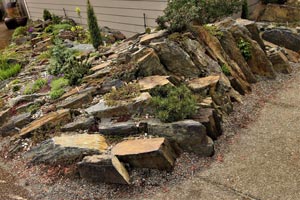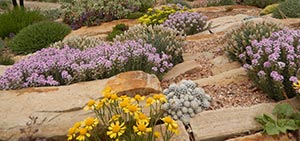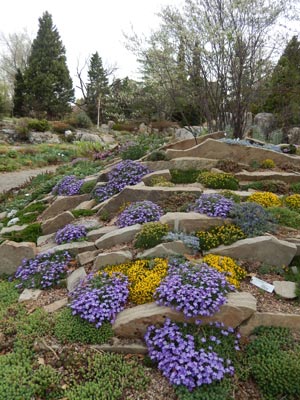|
How did we get here?
A brief history of the brief history of Crevice Gardening
|
Crevice Gardening
for the Masses and recent News
|
From Big Rocks to Little Rocks
|
Zoom Fatigue?
Don't worry we have a break
after the first three lectures
|
|
Crevice gardens are the best way to grow rock garden plants, but why did it take rock gardeners this long to make it a movement? In this talk, Paul will look into the history of crevice gardening in the broad context of international rock gardening. He will follow the lineage that has brought us to where we are today through a close up look at key figures, their gardens, and the plants they grow.
|
Kenton will be giving a plain-speak talk that is a prototype for Crevice Garden Construction guidance aimed at the general public, and he asks you for help: feedback from his peers on palatability and clarity of the message so we can share this garden style with everyone. The latter half will be news of most recent innovations, gardens, front-lines, and people in the Crevice garden realm.
|
The chronicle of stone is simple but enduring…it is a natural progression from big rocks to little rocks, brought to life by flora. Brevity and perpetuity cultivated together; Jeremy gathers stones in the garden to voice this story. Jeremy will share his tactics for creating dynamic crevice and boulder installations. Jeremy constructs crevice gardens for the Juniper Level Botanic Garden, Raleigh, North Carolina.
|
 |
|
Between A Rock and
A Hardscape,
or When Schist Hits The Fan
|
Crevice Gardens for Small Spaces
|
From the Mighty to the Modest
|
 |
|
Crevice gardening presents a whole new world of plants to the dry land gardener, and, a whole new array of challenges. If you are dealing with trying to fit a new and ambitious crevice garden into an existing, mature home garden surrounded by kids and trees on all sides, solutions aren't easy, or obvious. And, it turns out, you can carefully study, view, draw, and help build crevice gardens, but it doesn’t make you an expert. Some things have to be learned. This talk details the ongoing construction of a limestone crevice garden, as well as other local examples along the Wasatch Front in order to bring a bit of steppic, desert, and alpine plant treasures into our gardens.
|
Let’s talk about crevice gardens for small spaces. Yes, postage-stamp sized spaces! Jay will share inspiration and ideas from familiar friends and his natural surroundings in British Columbia and beyond. He will also also discuss his experience building budget-conscious crevice gardens accommodating tight geographic constraints and maximizing microclimate opportunities.
.
Jay is a rock gardening enthusiast with gardens in both Greater Vancouver and high on the Thompson Plateau in British Columbia's interior region
|
The current chair of the Nova Scotia Rock Garden Society, Roslyn will present the new limestone crevice garden at Dalhousie Agricultural Campus. It is a small crevice garden using recycled concrete.
The older existing rock garden contains 450 tons of local red granite. It features a collection of dwarf conifers and alpine and saxatile plants. The garden not only beautifies the campus but also offers environmental horticulture students opportunities to gain experience with uncommon plants. The garden also features two cedar bridges constructed by students in the wood construction techniques class.
|
 |